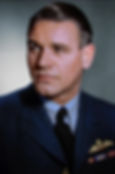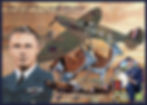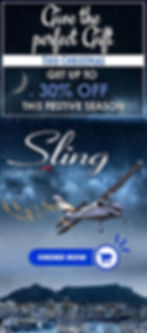Adolph Gysbert "Sailor" Malan: The Legendary South African Fighter Ace
- Garth Calitz
- May 28
- 7 min read
By Rob Russell

Adolph Gysbert "Sailor" Malan was one of the most distinguished fighter pilots of World War II, renowned for his exceptional combat skills, leadership, and unwavering commitment to freedom. A South African by birth, Malan became a symbol of courage and tactical brilliance in the Royal Air Force (RAF), playing a pivotal role in the Battle of Britain. His legacy extended beyond his military Achievements, as he later became an outspoken advocate against apartheid in South Africa.

Early Life and Naval Career
Born on October 3, 1910, in Wellington, in the Cape Province, Malan initially pursued a career in the maritime navy. He joined the South African Training Ship General Botha in 1924 as a naval cadet at the age of 14. On 5 January 1928, he engaged as an officer cadet aboard the Landsdowne Castle of the Union-Castle Line, which later earned him the nickname "Sailor" among his pilot colleagues. On 19 February 1932, he joined the Royal Naval Reserve as an acting sub-lieutenant and was commissioned a sub-lieutenant on 18 June 1935. However, his passion for aviation led him to join the Royal Air Force (RAF) in 1935, where he quickly distinguished himself as a skilled pilot.

Royal Air Force
In 1935, the Royal Air Force (RAF) started the rapid expansion of its pilot corps, for which Malan volunteered. He learned to fly in the de Havilland Tiger Moth at an elementary flying school near Bristol, flying for the first time on 6 January 1936. He was commissioned as an acting pilot officer on 2 March, completed training by the end of the year, and was sent to join 74 Squadron on 20 December 1936. He was confirmed as a pilot officer on 6 January 1937. He was promoted to Acting Flying Officer on 20 May 1938 and to Substantive Flying Officer on 6 July. He received another promotion to acting flight lieutenant on 2 March 1939, six months before the outbreak of war.

During his time in the RAF, he, amongst other things, developed the ten golden rules of air-to-air fighting. These rules still exist today, and whilst extensively modified, are used as a basis of aerial fighting by many Air Forces throughout the world.
"TEN OF MY RULES FOR AIR FIGHTING"
Wait until you see the whites of his eyes. Fire short bursts of 1 to 2 seconds and only when your sights are definitely 'ON'.
Whilst shooting, think of nothing else, brace the whole of the body, have both hands on the stick, concentrate on your ring sight.
Always keep a sharp lookout. "Keep your finger out!"
Height gives you the initiative.
Always turn and face the attack.
Make your decisions promptly. It is better to act quickly, even though your tactics are not the best.
Never fly straight and level for more than 30 seconds in the combat area.
When diving to attack, always leave a proportion of your formation above to act as top guard.
INITIATIVE, AGGRESSION, AIR DISCIPLINE, and TEAM WORK are the words that MEAN something in Air Fighting.
Go in quickly – Punch hard – Get out!

Dunkirk May 1940 - a career highlight

After fierce fighting over Dunkirk during the evacuation of the British Army from Dunkirk on 28 May 1940, Malan was awarded the Distinguished Flying Cross (DFC), having achieved five "kills". Malan and his senior pilots abandoned the Vic formation used by the RAF and turned to a looser formation (the finger-four) similar to the four aircraft Schwarm the Luftwaffe had developed during the Spanish Civil War, for their Heinkel He 111 bombers. A then-unique feat for which a bar was awarded to his DFC. On 6 July, he was promoted to flight lieutenant.

What is the difference between the two formations?
The Vic formation is a formation devised for military aircraft and first used during the First World War. It has three or sometimes more aircraft flying in close formation with the leader at the apex and the rest of the flight en echelon to the left and the right, the whole resembling the letter "V". The formation also allowed the fliers to see one another and communicate by hand signals and allowed them to stay together in poor visibility or cloud. Later, when bomber and reconnaissance flights came under attack from fighter aircraft, the Vic proved to have good defensive characteristics. Pilots, looking inwards to maintain formation, could overlook one another for attackers, and their observer/rear gunners could use interlocking fire to protect one another.

The finger-four formation (also known as the "four finger formation" and the "Fingertip Formation") is a flight formation used by fighter aircraft. It consists of four aircraft, and four of these formations can be combined into a squadron formation. The formation consists of a flight of four aircraft, consisting of a "lead element" and a "second element", each of two aircraft. When viewing the formation from above, the positions of the planes resemble the tips of the four fingers of a human right hand (without the thumb), giving the formation its name. The lead element is made up of the flight leader at the very front of the formation and one wingman to his rear left. The second element is made up of an additional two planes, the element leader and his wingman. The element leader is to the right and rear of the flight leader, followed by the element wingman to his right and rear.

Both the flight leader and element leader have offensive roles, in that they are the ones to open fire on enemy aircraft while the flight remains intact. Their wingmen have a defensive role—the flight wingman covers the rear of the second element and the element wingman covers the rear of the lead element. The aircraft in the formation had greater vertical and horizontal separation, and so they were free to scan in all directions for enemy aircraft, rather than focusing on maintaining a close formation. That allowed the pilots to maintain greater situational awareness and reduced their chance of being spotted by the enemy. The two pairs could split and attack on their own. The pilot who spotted the enemy would become the leader of the pair or even the whole flight for the duration of the attack, as he had the best situational awareness at that moment.

Four of these flights can be assembled to form a squadron formation, which consists of two staggered lines of fighters, one in front of the other. Each flight is usually designated by a colour (i.e. Red, Blue, Yellow, and Green).
One disadvantage of the finger-four formation was that it left the least-experienced flier, the number two wingman, in the most exposed position (as "tail-end Charlie"). These were particularly vulnerable to a surprise diving attack, and in some cases could be picked off without the others in the formation even noticing.

Post-war opposition to apartheid
After the conclusion of the war, Malan resigned his commission with the Royal Air Force in April 1946, retaining the rank of group captain, and returned home to South Africa, where he commenced a career in sheep farming at a farm not far from Kimberley. He maintained his ties to the RAF community, however, acting as president of the Royal Air Forces Association’s South African Area and becoming a life-member of its Johannesburg Branch.


In the early 1950s, he became involved in increasingly volatile South African domestic politics with its radical, polarising atmosphere and racially and culturally divided societal tensions. After the National Party was voted into government in the late 1940s, South Africa's domestic governance moved to a position of national conservatism and introduced apartheid, which Malan objected to. In the early 1950s, Malan joined a liberal politically organised protest movement opposed to the introduction of the apartheid system, styling itself as the Torch Commando, of which, with his public recognition acquired from his war career, he was elected president.


The Torch Commando was a South African anti-apartheid organisation, born out of the work of the Springbok Legion, a South African organisation of World War II founded in 1941 during the Second World War, and the War Veterans Action Committee, established with the involvement of Springbok Legionnaires to appeal to a broader base of ex-servicemen. It was allegedly underwritten by Harry Oppenheimer, through an opaque trust fund, although there has been no firm proof of this.

The Springbok Legion was initially formed by members of the 9th Recce Battalion of the South African Tank Corps, the Soldiers' Interests Committee formed by members of the First South African Brigade in Addis Ababa, and the Union of Soldiers formed by the same brigade in Egypt.
The aims and objectives of the Springbok Legion were enunciated in its 'Soldiers Manifesto'. The Springbok Legion was open to all service personnel regardless of race or gender and was avowedly anti-fascist and anti-racist.

Amongst its leading members were servicemen such as Joe Slovo, Lionel Bernstein, Wolfie Kodesh, Jack Hodgson and Fred Carneson, who all later joined the African National Congress and its military wing, Umkhonto we Sizwe, under the command of Nelson Mandela. Others, such as Harry Schwarz, a later well-known anti-apartheid political leader, lawyer and ambassador to the United States during the first government of national unity, were among the organisation's founders.


Another member was General Kenneth van der Spuy, one of the founding members of the South African Air Force, who fought in both World War I and World War II and was captured and imprisoned in the Kremlin by the Russians after fighting alongside the White Russian forces against the communists and held until 1920.
The Torch Commando existed for more than five years, and at its height claimed to have had 250,000 members. The government was alarmed by the number of judges, public servants and military officers joining the organisation, and a new law was passed to ban anyone in public service or the military from joining. Subsequently, the National Party did everything to purge the memory of the Springbok Legion, Torch Commando and men such as 'Sailor' Malan, who had an appeal with white Afrikaner youth.

Malan died at the age of 52 on 17 September 1963 from Parkinson's disease, at the time a rare and little-understood medical condition. A considerable sum of money was raised in his name to further study the disease. His funeral service was at St Cyprian's Cathedral, Kimberley, and his body was buried at West End Cemetery in Kimberley. Due to his prominent role in opposition to apartheid, the South African government sought to marginalise the event of his passing to further erase any lasting legacy of the Torch Commando.

Malan was not permitted a military funeral and all South African military personnel who attended his funeral were instructed not to wear their uniforms. The South African Air Force was instructed not to give any tribute to his passing. His funeral was, however, attended by two officers from the US Military, dressed in full uniform.

Gysbert Malan, as he was known to many of his friends, was a true legend who not only influenced many thoughts in aerial combat warfare, and played a huge and important part in the outcome of World War 2, but also the political future of SA. There are many people worldwide who owe their lives to him and his thinking. His contributions to the Battle of Britain and his later stand against apartheid cement his place as one of history's most remarkable figures.




























